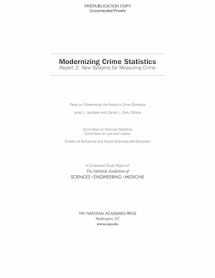
Modernizing Crime Statistics: Report 2: New Systems for Measuring Crime
ISBN-13:
9780309472616
ISBN-10:
030947261X
Edition:
Illustrated
Author:
Engineering National Academies of Sciences, Division of Behavioral and Social Sciences and Education, Committee on National Statistics, Committee on Law and Justice, Panel on Modernizing the Nations Crime Statistics, Cork
Publication date:
2018
Publisher:
National Academies Press
Format:
Paperback
280 pages
FREE US shipping
Book details
ISBN-13:
9780309472616
ISBN-10:
030947261X
Edition:
Illustrated
Author:
Engineering National Academies of Sciences, Division of Behavioral and Social Sciences and Education, Committee on National Statistics, Committee on Law and Justice, Panel on Modernizing the Nations Crime Statistics, Cork
Publication date:
2018
Publisher:
National Academies Press
Format:
Paperback
280 pages
Summary
Modernizing Crime Statistics: Report 2: New Systems for Measuring Crime (ISBN-13: 9780309472616 and ISBN-10: 030947261X), written by authors
Engineering National Academies of Sciences, Division of Behavioral and Social Sciences and Education, Committee on National Statistics, Committee on Law and Justice, Panel on Modernizing the Nations Crime Statistics, Cork, was published by National Academies Press in 2018.
With an overall rating of 3.5 stars, it's a notable title among other
books. You can easily purchase or rent Modernizing Crime Statistics: Report 2: New Systems for Measuring Crime (Paperback) from BooksRun,
along with many other new and used
books
and textbooks.
And, if you're looking to sell your copy, our current buyback offer is $0.3.
Description
To derive statistics about crime â€" to estimate its levels and trends, assess its costs to and impacts on society, and inform law enforcement approaches to prevent it - a conceptual framework for defining and thinking about crime is virtually a prerequisite. Developing and maintaining such a framework is no easy task, because the mechanics of crime are ever evolving and shifting: tied to shifts and development in technology, society, and legislation. Interest in understanding crime surged in the 1920s, which proved to be a pivotal decade for the collection of nationwide crime statistics. Now established as a permanent agency, the Census Bureau commissioned the drafting of a manual for preparing crime statisticsâ€"intended for use by the police, corrections departments, and courts alike. The new manual sought to solve a perennial problem by suggesting a standard taxonomy of crime. Shortly after the Census Bureau issued its manual, the International Association of Chiefs of Police in convention adopted a resolution to create a Committee on Uniform Crime Records â€"to begin the process of describing what a national system of data on crimes known to the police might look like. Report 1 performed a comprehensive reassessment of what is meant by crime in U.S. crime statistics and recommends a new classification of crime to organize measurement efforts. This second report examines methodological and implementation issues and presents a conceptual blueprint for modernizing crime statistics.


We would LOVE it if you could help us and other readers by reviewing the book
Book review

Congratulations! We have received your book review.
{user}
{createdAt}
by {truncated_author}


